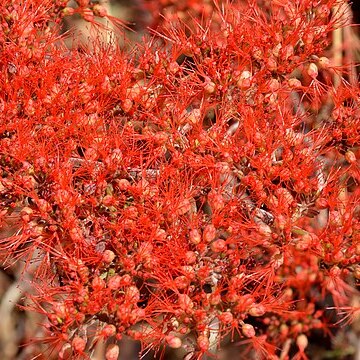A shrub. It loses its leaves during the year. It can lie along the ground. It grows 2-3 m tall. The young branches have a coating. The leaves are oppositeThe flowers are in large groups at the ends of branches. They are red. The fruit can be 5 cm long by 3.3 cm wide.
Inflorescences of large leafy or leafless terminal and axillary panicles; rhachis tomentose; bracts c. 2 mm. long, often transitional to small inflorescence-leaves which are in turn transitional to normal foliage.
Lower receptacle 3·5–4·5 mm. long, somewhat constricted above and below the ovary, densely greyish-or fulvous-pubescent; upper receptacle 2·5–3·5 x 1·5–3 mm., usually greyish-or silvery-sericeous.
Liane or scandent shrub, 2-3 m high. Stems armed with slightly recurved spines. Leaves usually subcircular, usually tomentose at least when young. Fruit 20 mm long. Flowers red.
A deciduous scandent or ± prostrate shrub; bark grey-brown or creamy-brown; branchlets tomentose when young and usually only tardily glabrescent, often pale.
Fruit usually as in C. paniculatum (normally c. 2 x 2 cm.) but occasionally up to c. 5 x 3·3 cm.
Petals red, 2–2·5 x 2 mm., subcircular, usually overlapping and connivent, glabrous.
Flowers 4-merous, sessile or nearly so, red (due to red petals and stamens).
Disk rather inconspicuous, without a free margin.
Stamen-filaments 10–13 mm. long; 0·9 mm. long.
Sepals up to 0·9 x 1·2 mm.
Style 8–10 mm. long.

